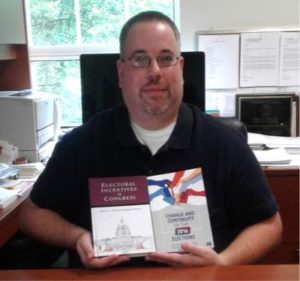
Dr. Jamie Carson’s most recent book, Electoral Incentives in Congress, is the literary manifestation of conversations Carson had with one of his graduate students, Joel Sievert. Throughout Sievert’s time at UGA, he and Carson would get lunch and discuss Congress. One of the topics that invariably came up was how much motivation for re-election influences members of Congress and if it had always been that way. They decided to study the topic and recently published their findings as a book.
“We found that there is an electoral incentive across time, since the beginning of the nation. In fact, it was almost as strong at some points in the nineteenth century as it is today. Because members of Congress write the rules, they can design a system to sort of advantage themselves. And from Day One that’s essentially what they did.”
But Carson doesn’t see this as a bad thing, he explains by quoting Madison, “‘Ambition must be made to counteract ambition,’ if you really want people to be responsive, you have to make an incentive for them to be responsive.” The promise of re-election serves as an incentive for members of Congress to be responsive to their constituents.
However, Carson doesn’t believe that this conclusion means everything in Congress is perfect. He believes we still have other issues to iron out. “I’d say money is a much bigger problem today than the fact that members care about re-election.”
Earlier this year, Jamie Carson also published the 2016 election edition of Change and Continuity, a long-standing series that is published after every major election to illuminate the results. Carson served as a research assistant on the 1998, 2000, and 2002 versions while he was in graduate school. When he was asked to co-author the newest edition, he was excited to get back to his roots while analyzing such an interesting election.
Change and Continuity includes chapters on the fall campaign, analyses of the election results, and explanations and analysis of legislative actions and behavior leading up to the election. “What’s neat about this book is that it’s the first synthesis of systematic data that analyzes what happened. It looks at an aggregate of election returns but also analyzes survey evidence to figure out why the voters picked this group of candidates and what it ultimately means for the larger system.”
“Trying to put 2016 into context was a challenge,” Carson reflects. “But, the more we analyzed this election, the more it looked like past elections. There’s an unusual outcome but the same groups of people that would typically vote for a Republican, voted for Trump. It’s not like he attracted more blue collar workers, which was the understanding, or women fled from him–that didn’t happen either. It was the same patterns, but just a little more stark.”
Carson is hoping that people will read Change and Continuity and realize that what they thought they knew about the election is significantly more nuanced. He will start working on the next edition of Change and Continuity after the 2018 midterm elections. Carson will also be presenting a paper on congressional primary elections at the American Political Science Association Meeting in Boston this year.








